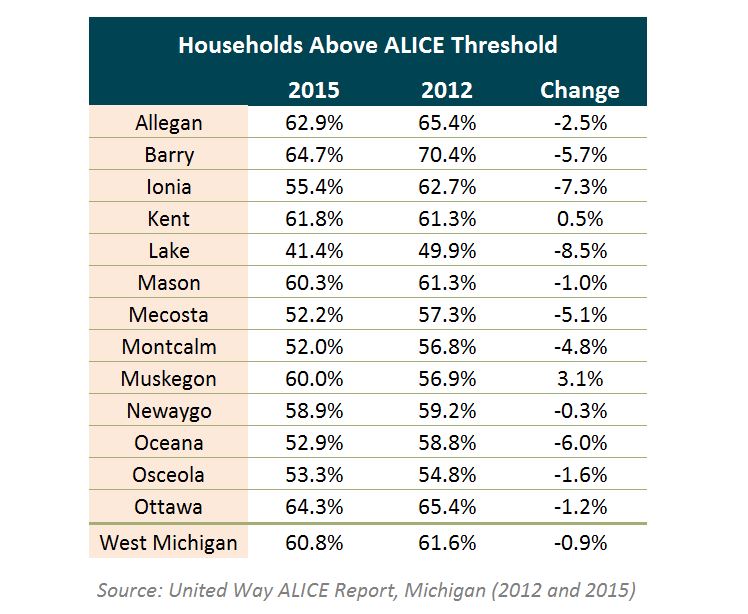We’ve written in the past about the ALICE Project from the United Way (ALICE stands for Asset Limited, Income Constrained, Employed), and how the valuable research from this report helps inform the work of our Workforce Development Working Group. Since the project began in New Jersey in 2009, more states have joined to create statewide reports to inform the public of those who are struggling to provide themselves with basic necessities.
Michigan was a part of the first cohort to release a report, which utilized 2012 U.S. Census Bureau American Community Survey (ACS) data. Recently, the United Way released an update to the first report, using much newer 2015 ACS data.
West Michigan numbers show little change
Unfortunately, the 13-county West Michigan region saw little change in the proportion of households above the ALICE threshold from the old report to the new one. In 2012, 61.6% of households in West Michigan were above the “Survival Budget Threshold” (based on an example budget of essential goods, determined on a county-by-county basis; these are available in the report). However, with this most recent update, we see that in 2015, 60.8% of households are above this threshold. This is a decrease of almost a full percentage point.
Looking at the nearly-forty percent of households that are struggling to make ends meet below the Survival Budget Threshold, there were some movements with respect to where they fall in relation to the poverty line (which is lower than the Survival Budget Threshold). From 2012 to 2015, the percentage of households below the poverty level in West Michigan dropped from 14.6% to 12.7%. However, these households likely didn’t rise to a level of sustainability; the proportion of households above poverty but still below the ALICE threshold grew from 23.7% to 26.5% over the same time period.
Counties tell a mixed message in new report
From a county level, we see that from 2012 to 2015, 11 of the region’s 13 counties saw a decrease in the proportion of households above the ALICE threshold. Some of the largest drops occurred in Lake County (which fell from 49.9% to 41.4%), Ionia County (62.7% to 55.4%), and Oceana County (58.8% to 52.9%). However, two of the three largest counties in West Michigan saw the proportion of households above ALICE increase. Kent County saw slight uptick of 0.5%, while Muskegon’s proportion grew by 3.1%.

More research and reading is available
The Workforce Development Working Group of Talent 2025 has been working through the innovation process to help engage more individuals in the labor force, as well as tackle the barriers to sustainable employment (see our Persona Project to learn more about individuals struggling with these barriers). The group is now conducting in-depth research to find the right programs to pilot which could help job-seekers and workers below the ALICE threshold succeed in the workforce. The full 2017 Michigan ALICE Report is available here on the United Way website.


